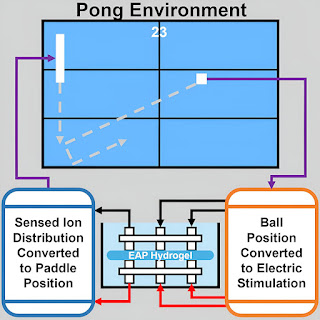Credit: Cell Reports Physical Science (2024). DOI: 10.1016/j.xcrp.2024.102151
In
a study published22 August
in Cell Reports Physical Science, a
team led by Dr. Yoshikatsu Hayashi demonstrated that a simple hydrogel—a type
of soft, flexible material—can learn to play the simple 1970s computer game
"Pong." The hydrogel, interfaced with a computer simulation of the
classic game via a custom-built multi-electrode array, showed improved
performance over time.
Dr. Hayashi, a biomedical engineer at
the University of Reading's School of Biological Sciences, said, "Our
research shows that even very simple materials can exhibit complex, adaptive
behaviors typically associated with living systems or sophisticated AI.
"This opens up exciting
possibilities for developing new types of 'smart' materials that can learn and
adapt to their environment."
The emergent learning behavior is
thought to arise from movement of charged particles within the hydrogel in
response to electrical stimulation, creating a form of 'memory' within the material
itself.
"Ionic hydrogels can achieve the
same kind of memory mechanics as more complex neural networks," says first author and robotics engineer,
Vincent Strong of the University of Reading. "We showed that hydrogels are
not only able to play Pong, they can actually get better at it over time."
The researchers were inspired by a
previous study that showed that brain cells in a dish can learn to play Pong if they are
electrically stimulated in a way that gives them feedback on their performance.
"Our paper addresses the question
of whether simple artificial systems can compute closed loops similar to the
feedback loops that allow our brains to control our bodies," said Dr.
Hayashi, a corresponding author on the study.
"The basic principle in both
neurons and hydrogels is that ion migration and distributions can work as a
memory function which can correlate with sensory-motor loops in the Pong world.
In neurons, ions run within the cells. In the gel, they run outside."
Because most existing AI algorithms are derived from neural networks, the researchers say that hydrogels represent a different kind of "intelligence" that could be used to develop new, simpler algorithms. In the future, the researchers plan to further probe the hydrogel's "memory" by examining the mechanisms behind its memory and by testing its ability to perform other tasks.
Gel plays Pong. Credit: Cell Reports
Physical Science/Strong et al.
Beating gel mimics heart tissue
In a recent related study, published in the Proceedings of the National
Academy of Sciences, Dr. Hayashi's team, along with Reading colleagues Dr.
Zuowei Wang and Dr. Nandini Vasudevan, demonstrated how a different hydrogel
material can be taught to beat in rhythm with an external pacemaker. This is
the first time this has been achieved using a material other than living cells.
The researchers demonstrated how
a hydrogel material oscillates chemically and mechanically,
much like the way heart muscle cells contract in unison. They provide
theoretical interpretation of these dynamic behaviors.
The researchers found that by
applying cyclic compressions to the gel, they could entrain its chemical
oscillations to sync with the mechanical rhythm. The gel retained a memory of
this entrained beating even after the mechanical pacemaker was stopped.
"This is a significant step
towards developing a model of cardiac muscle that might one day be used to
study the interplay of mechanical and chemical signals in the human
heart," Dr. Hayashi said. "It opens up exciting possibilities for replacing
some animal experiments in cardiac research with these
chemically-powered gel models."
Lead author of the study, Dr. Tunde
Geher-Herczegh, said the findings could provide new ways to investigate cardiac arrhythmia, a condition in which the heart beats too fast, too
slow or irregularly, which affects more than 2 million people in the UK.
She said, "An irregular heart
beat can be managed with drugs or an electrical pacemaker, but the complexity
of biological heart cells makes it difficult to study the underlying mechanical
systems, independently from the chemical and electrical systems in the heart.
"Our findings could lead to
new discoveries and potential treatments for arrythmia, and will contribute to
our understanding of how artificial materials could be used in place of animals
and biological tissues, for research and treatments in the future."
Implications and future directions
These studies, bridging concepts
from neuroscience, physics, materials science, and cardiac research, suggest
that the fundamental principles underlying learning and adaptation in living
systems might be more universal than previously thought.
The research team believes their
findings could have far-reaching implications for fields ranging from soft
robotics and prosthetics to environmental sensing and adaptive materials.
Future work will focus on developing more complex behaviors and exploring potential real-world applications, including the development of alternative lab models for advancing cardiac research and reducing the use of animals in medical studies.
Source: Pong
prodigy: Hydrogel material shows unexpected learning abilities (phys.org)

No comments:
Post a Comment